Urry D.W. (Ed.) What Sustains Life? : Consilient Mechanisms for Protein-Based Machines and Materials
Подождите немного. Документ загружается.

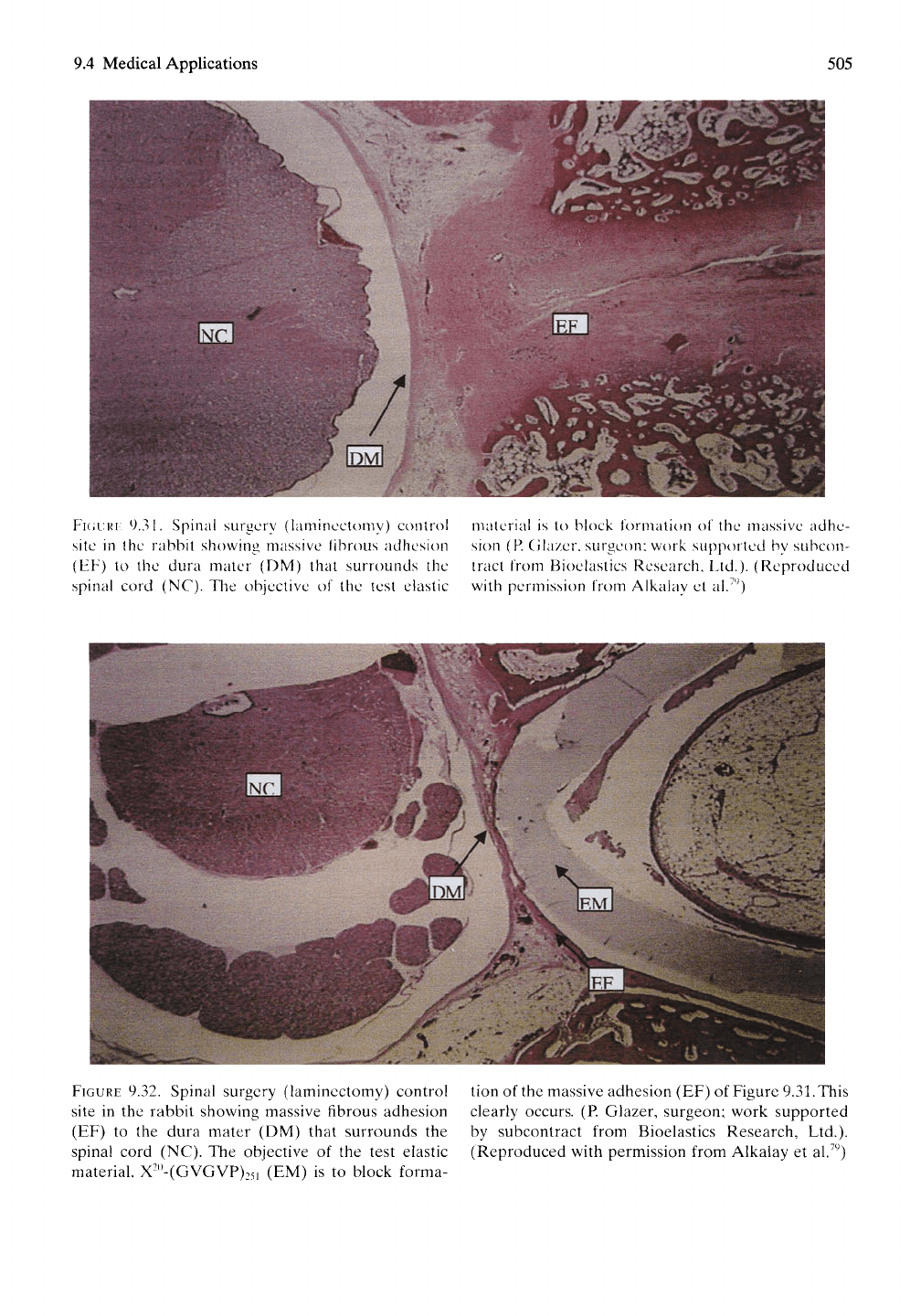
9.4 Medical Applications
505
FKJURI:
9.31. Spinal surgery (laminectomy) control material is to block formation of the massive adhe-
site in the rabbit showing massive fibrous adhesion sion (P. Glazer, surgeon; work supported by subcon-
(EF) to the dura mater (DM) that surrounds the tract from Bioelastics Research, Ltd.). (Reproduced
spinal cord (NC). The objective of the test elastic with permission from Alkalay et al.^'^
FIGURE
9.32. Spinal surgery (laminectomy) control
site in the rabbit showing massive fibrous adhesion
(EF) to the dura mater (DM) that surrounds the
spinal cord (NC). The objective of the test elastic
material, X-"-(GVGVP)25i (EM) is to block forma-
tion of the massive adhesion (EF) of Figure
9.31.
This
clearly occurs. (P. Glazer, surgeon; work supported
by subcontract from Bioelastics Research, Ltd.).
(Reproduced with permission from Alkalay et al.'^'^)
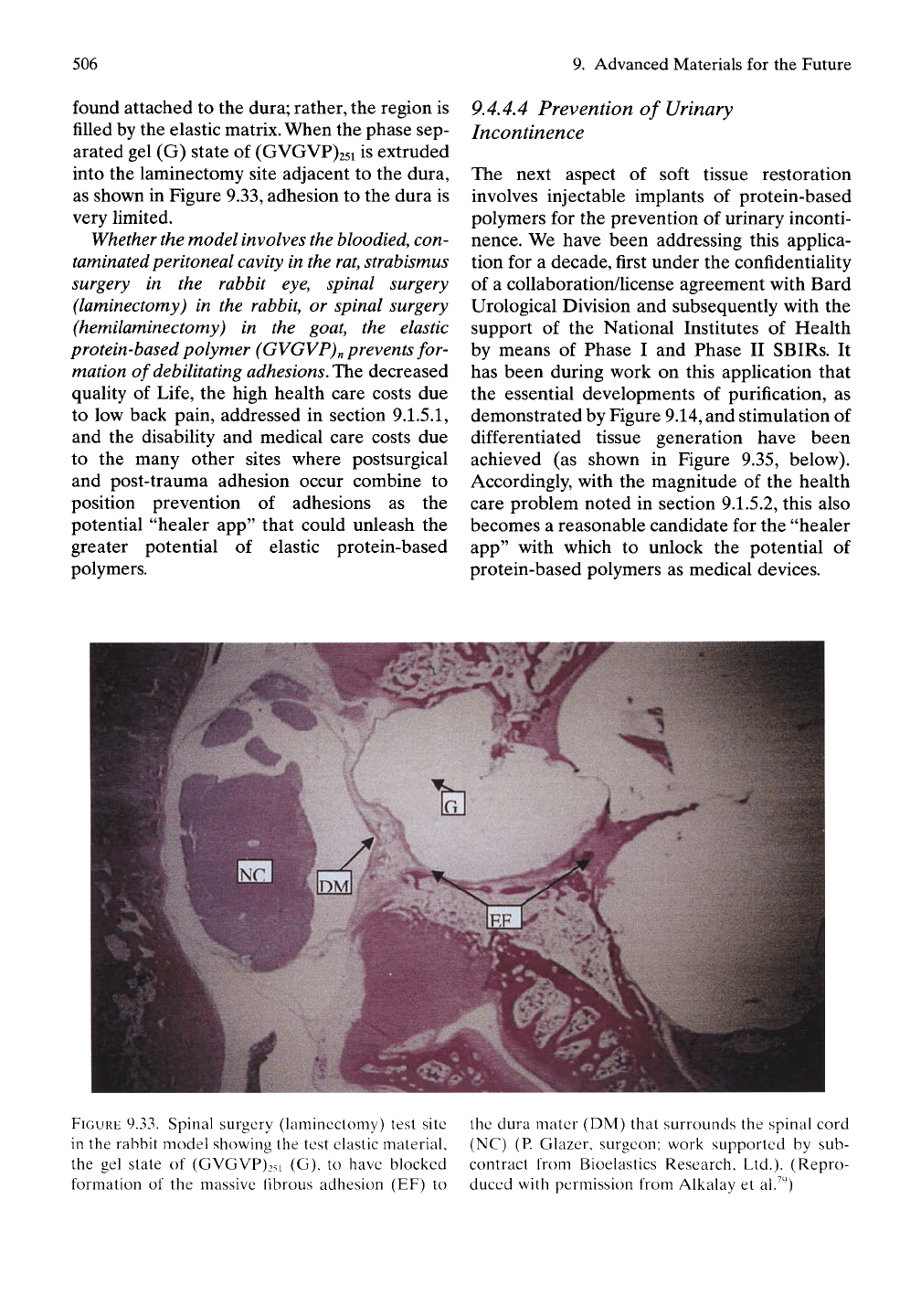
506 9. Advanced Materials for the Future
found attached to the dura; rather, the region is
filled by the elastic
matrix.
When the phase sep-
arated gel (G) state of (GVGVP)25i is extruded
into the laminectomy site adjacent to the dura,
as shown in Figure
9.33,
adhesion to the dura is
very limited.
Whether the
model
involves the
bloodied,
con-
taminated peritoneal
cavity
in the
rat,
strabismus
surgery in the rabbit eye, spinal surgery
(laminectomy) in the rabbit, or spinal surgery
(hemilaminectomy) in the goat, the elastic
protein-based
polymer
(GVGVP)n prevents
for-
mation of
debilitating
adhesions.
The decreased
quality of Life, the high health care costs due
to low back pain, addressed in section
9.1.5.1,
and the disability and medical care costs due
to the many other sites where postsurgical
and post-trauma adhesion occur combine to
position prevention of adhesions as the
potential "healer app" that could unleash the
greater potential of elastic protein-based
polymers.
9.4 A A Prevention of Urinary
Incontinence
The next aspect of soft tissue restoration
involves injectable implants of protein-based
polymers for the prevention of urinary inconti-
nence. We have been addressing this applica-
tion for a decade, first under the confidentiality
of a collaboration/license agreement with Bard
Urological Division and subsequently with the
support of the National Institutes of Health
by means of Phase I and Phase II SBIRs. It
has been during work on this application that
the essential developments of purification, as
demonstrated by Figure
9.14,
and stimulation of
differentiated tissue generation have been
achieved (as shown in Figure 9.35, below).
Accordingly, with the magnitude of the health
care problem noted in section 9.1.5.2, this also
becomes a reasonable candidate for the "healer
app"
with which to unlock the potential of
protein-based polymers as medical devices.
FIGURE
9.33. Spinal surgery (laminectomy) test site
in the rabbit model showing the test elastic material,
the gel state of (GVGVP)25i (G), to have blocked
formation of the massive fibrous adhesion (EF) to
the dura mater (DM) that surrounds the spinal cord
(NC) (P. Glazer, surgeon; work supported by sub-
contract from Bioelastics Research, Ltd.). (Repro-
duced with permission from Alkalay et al.^*^)
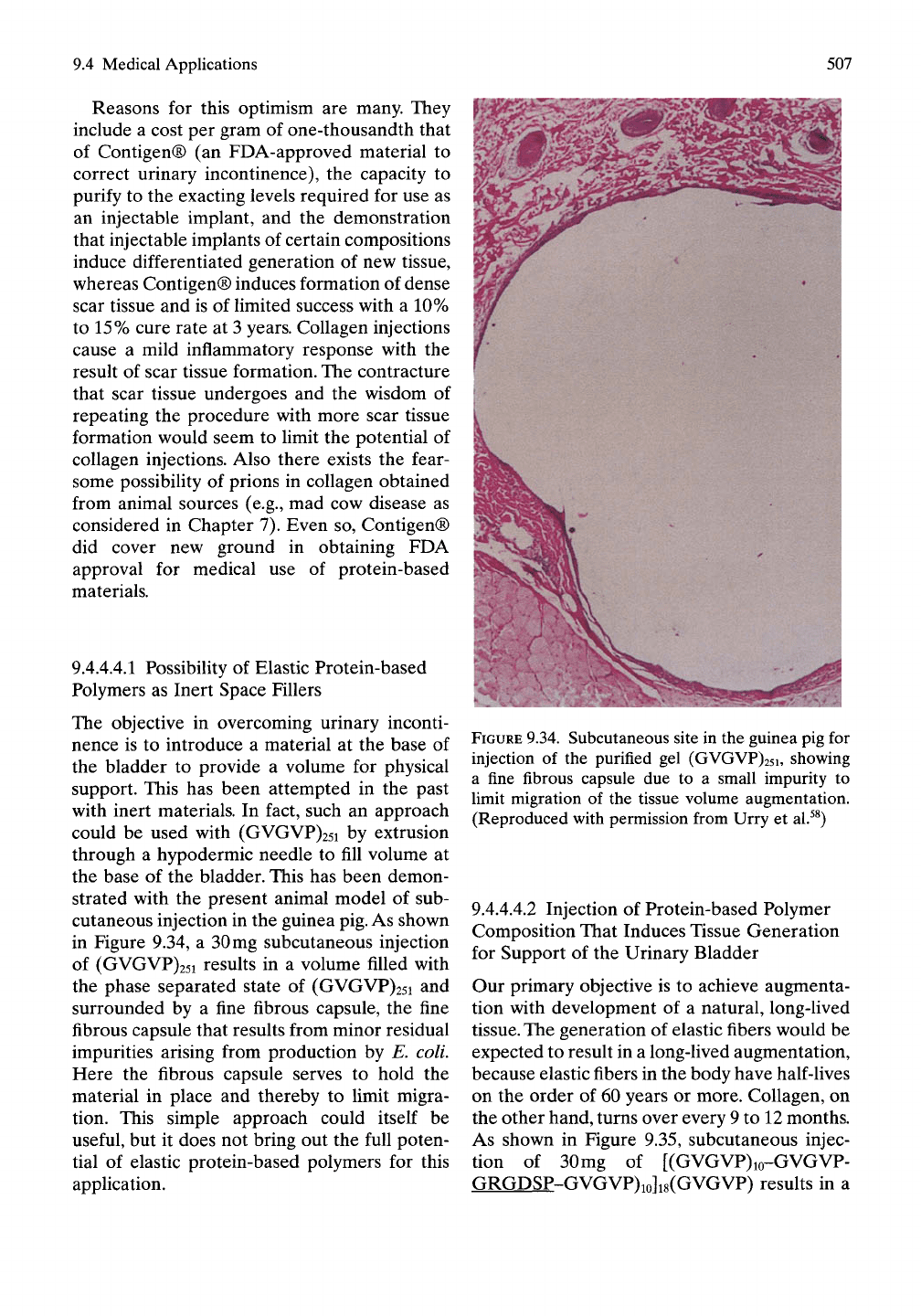
9.4 Medical Applications 507
Reasons for this optimism are many. They
include a cost per gram of one-thousandth that
of Contigen® (an FDA-approved material to
correct urinary incontinence), the capacity to
purify to the exacting levels required for use as
an injectable implant, and the demonstration
that injectable implants of certain compositions
induce differentiated generation of new tissue,
whereas Contigen® induces formation of dense
scar tissue and is of limited success with a 10%
to 15% cure rate at 3 years. Collagen injections
cause a mild inflammatory response with the
result of scar tissue formation. The contracture
that scar tissue undergoes and the wisdom of
repeating the procedure with more scar tissue
formation would seem to limit the potential of
collagen injections. Also there exists the fear-
some possibiUty of prions in collagen obtained
from animal sources (e.g., mad cow disease as
considered in Chapter 7). Even so, Contigen®
did cover new ground in obtaining FDA
approval for medical use of protein-based
materials.
9.4.4.4.1 Possibility of Elastic Protein-based
Polymers as Inert Space Fillers
The objective in overcoming urinary inconti-
nence is to introduce a material at the base of
the bladder to provide a volume for physical
support. This has been attempted in the past
with inert materials. In fact, such an approach
could be used with (GVGVP)25i by extrusion
through a hypodermic needle to fill volume at
the base of the bladder. This has been demon-
strated with the present animal model of sub-
cutaneous injection in the guinea
pig.
As shown
in Figure 9.34, a 30mg subcutaneous injection
of (GVGVP)25i results in a volume filled with
the phase separated state of (GVGVP)25i and
surrounded by a fine fibrous capsule, the fine
fibrous capsule that results from minor residual
impurities arising from production by E. coli.
Here the fibrous capsule serves to hold the
material in place and thereby to limit migra-
tion. This simple approach could itself be
useful, but it does not bring out the full poten-
tial of elastic protein-based polymers for this
apphcation.
FIGURE 9.34. Subcutaneous site in the guinea pig for
injection of the purified gel (GVGVP)25i, showing
a fine fibrous capsule due to a small impurity to
limit migration of the tissue volume augmentation.
(Reproduced with permission from Urry et al.^^)
9.4.4.4.2 Injection of Protein-based Polymer
Composition That Induces Tissue Generation
for Support of the Urinary Bladder
Our primary objective is to achieve augmenta-
tion with development of a natural, long-lived
tissue. The generation of elastic fibers would be
expected to result in a long-lived augmentation,
because elastic fibers in the body have half-lives
on the order of 60 years or more. Collagen, on
the other hand, turns over every 9 to 12 months.
As shown in Figure 9.35, subcutaneous injec-
tion of 30 mg of [(GVGVP)io-GVGVP-
GRGDSP-GVGVP)io]i8(GVGVP) results in a

508
9. Advanced Materials for the Future
m-
4' '• • !
, -'?*•
•. V
•. ••"•!• •'•'•' .••'<v^;'-^'->-..•••• •
FIGURE
9.35. Subcutaneous site in the guinea pig
2 weeks after a 30mg injection of a highly purified
elastic protein material with a GRGDSP cell
attachment site, namely, [(GVGVP)ioGVGVP-
GRGDSP(GVGVP)io]7(GVGVP). (A) Low magni-
fication showing much tissue generation with
angiogenesis and some remaining polymer seen as
vesicles. (B) Higher magnification showing erythro-
cytes in capillaries and spindle-shaped fibroblastic
cells presumably synthesizing collagen and elastin
fibers. (Reproduced with permission from Urry
et al.^«)
tissue generation with what appears to be a
natural distribution of collagen and elastic
fibers. In particular, the generation of elastic
fibers would prevent contracture and would be
expected to result in a long lasting tissue gen-
eration, because the half-life for elastic fiber in
the human is of the order of a lifetime.
9.4.4.5 Plastic Surgery to Improve Body
Contours Formed by Soft Tissues
A composition could be injected to induce
tissue generation for improving body contour.
Wrinkle removal provides the simplest exten-
sion of tissue augmentation or generation, but
the concept could be applied at many sites
where soft tissue generation may be considered
a desirable result.
9.4.4.6 Temporary Functional Scaffoldings
for Soft Tissue Restoration
Whenever a dynamic structure fails or is so dis-
eased that it needs to be replaced, the concept
of temporary functional scaffoldings comes into
play. Examples are synthetic arteries, urinary
bladder, intervertebral discs, and even a tem-
porary functional scaffolding for skin replace-
ment, for example, after burns.
Each of these structures begins with a struc-
tural integrity and a dynamic functional range
that becomes lost through any number of
disease processes. In each of these cases and
many others, the concept of a temporary func-
tional scaffolding couples with the remodeling
capacity of natural cells sensing the demands of
a normal tissue environment to result in tissue
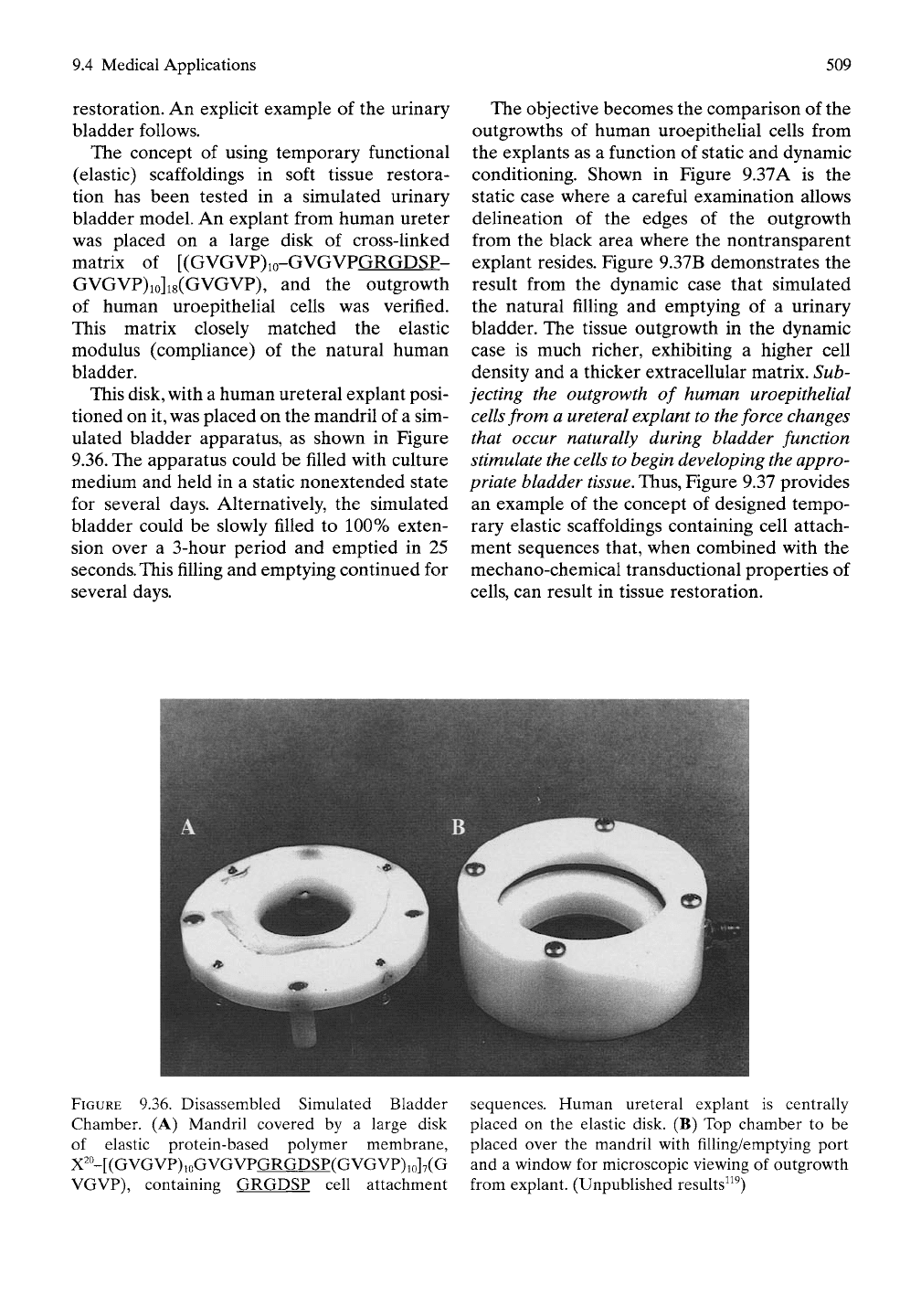
9.4 Medical Applications
509
restoration. An explicit example of the urinary
bladder follows.
The concept of using temporary functional
(elastic) scaffoldings in soft tissue restora-
tion has been tested in a simulated urinary
bladder model. An explant from human ureter
was placed on a large disk of cross-linked
matrix of [(GVGVP)io-GVGVPGRGDSP-
GVGVP)io]i8(GVGVP), and the outgrowth
of human uroepithelial cells was verified.
This matrix closely matched the elastic
modulus (compUance) of the natural human
bladder.
This disk, with a human ureteral explant posi-
tioned on it, was placed on the mandril of a sim-
ulated bladder apparatus, as shown in Figure
9.36. The apparatus could be filled with culture
medium and held in a static nonextended state
for several days. Alternatively, the simulated
bladder could be slowly filled to 100% exten-
sion over a 3-hour period and emptied in 25
seconds.
This filling and emptying continued for
several days.
The objective becomes the comparison of the
outgrowths of human uroepithelial cells from
the explants as a function of static and dynamic
conditioning. Shown in Figure 9.37A is the
static case where a careful examination allows
delineation of the edges of the outgrowth
from the black area where the nontransparent
explant resides. Figure 9.37B demonstrates the
result from the dynamic case that simulated
the natural filling and emptying of a urinary
bladder. The tissue outgrowth in the dynamic
case is much richer, exhibiting a higher cell
density and a thicker extracellular matrix. Sub-
jecting the outgrowth of human uroepithelial
cells from a ureteral explant to the force changes
that occur naturally during bladder function
stimulate the cells to begin developing the appro-
priate bladder tissue. Thus, Figure 9.37 provides
an example of the concept of designed tempo-
rary elastic scaffoldings containing cell attach-
ment sequences that, when combined with the
mechano-chemical transductional properties of
cells,
can result in tissue restoration.
FIGURE
9.36. Disassembled Simulated Bladder
Chamber. (A) Mandril covered by a large disk
of elastic protein-based polymer membrane,
X''-[(GVGVP)ioGVGVPGRGDSP(GVGVP)io]7(G
VGVP), containing GRGDSP cell attachment
sequences. Human ureteral explant is centrally
placed on the elastic disk. (B) Top chamber to be
placed over the mandril with filling/emptying port
and a window for microscopic viewing of outgrowth
from explant. (Unpublished results^^^)
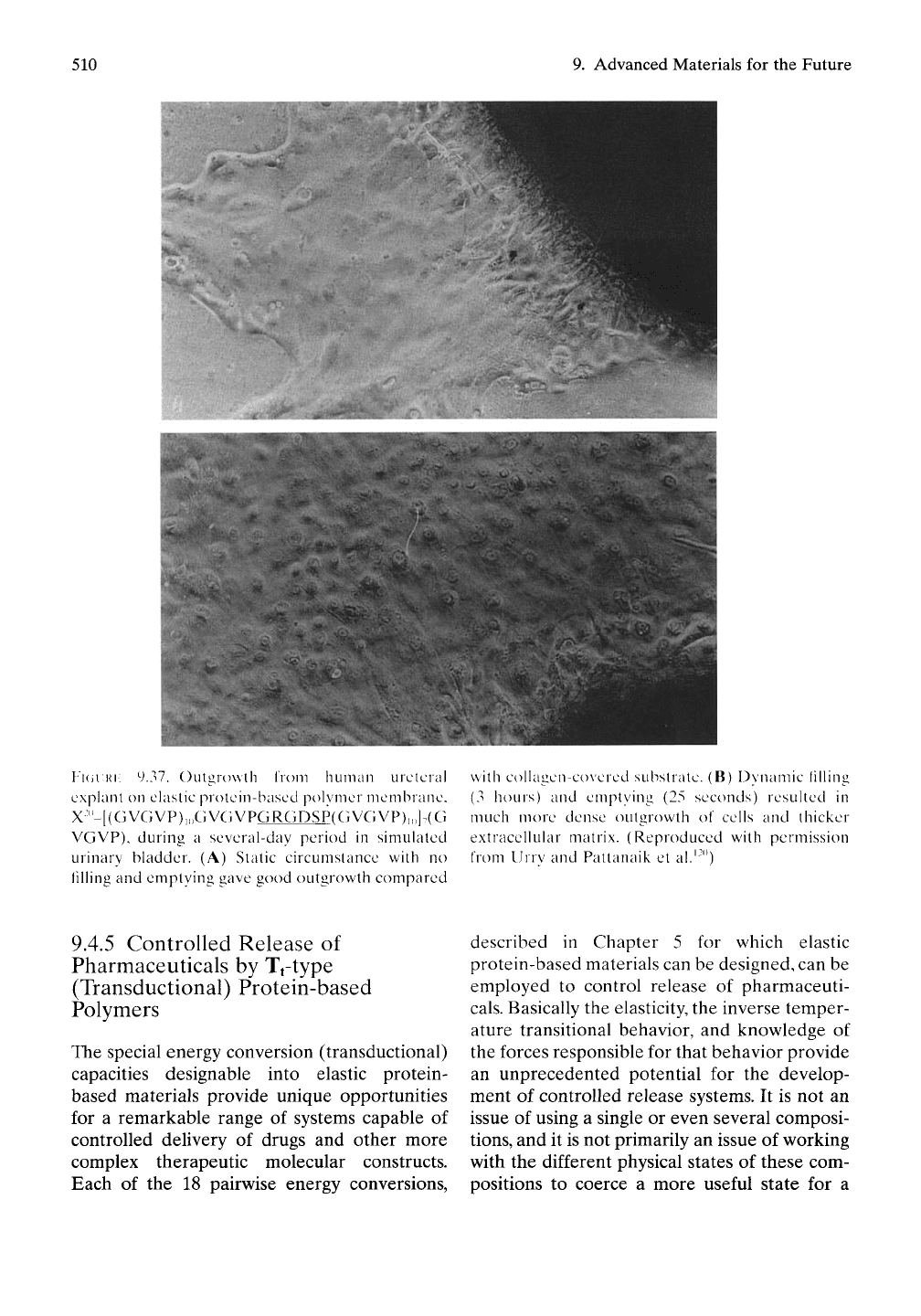
510
9. Advanced Materials for the Future
B
FKJURI:
9.37. Oulgrowlh from human ureteral
explanl on elastic protein-based polymer membrane,
X^"-[(GVGVP),oGVGVPGRGDSP(GVGVP),„]7(G
VGVP), during a several-day period in simulated
urinary bladder. (A) Static circumstance with no
filling and emptying gave good outgrowth compared
with collagen-covered substrate. (B) Dynamic filling
(3 hours) and emptying (25 seconds) resulted in
much more dense outgrowth of cells and thicker
extracellular matrix. (Reproduced with permission
from Urry and Pattanaik et al.'-'*)
9.4.5 Controlled Release of
Pharmaceuticals by Tftype
(Transductional) Protein-based
Polymers
The special energy conversion (transductional)
capacities designable into elastic protein-
based materials provide unique opportunities
for a remarkable range of systems capable of
controlled delivery of drugs and other more
complex therapeutic molecular constructs.
Each of the 18 pairwise energy conversions,
described in Chapter 5 for which elastic
protein-based materials can be designed, can be
employed to control release of pharmaceuti-
cals.
Basically the elasticity, the inverse temper-
ature transitional behavior, and knowledge of
the forces responsible for that behavior provide
an unprecedented potential for the develop-
ment of controlled release systems. It is not an
issue of using a single or even several composi-
tions,
and it is not primarily an issue of working
with the different physical states of these com-
positions to coerce a more useful state for a
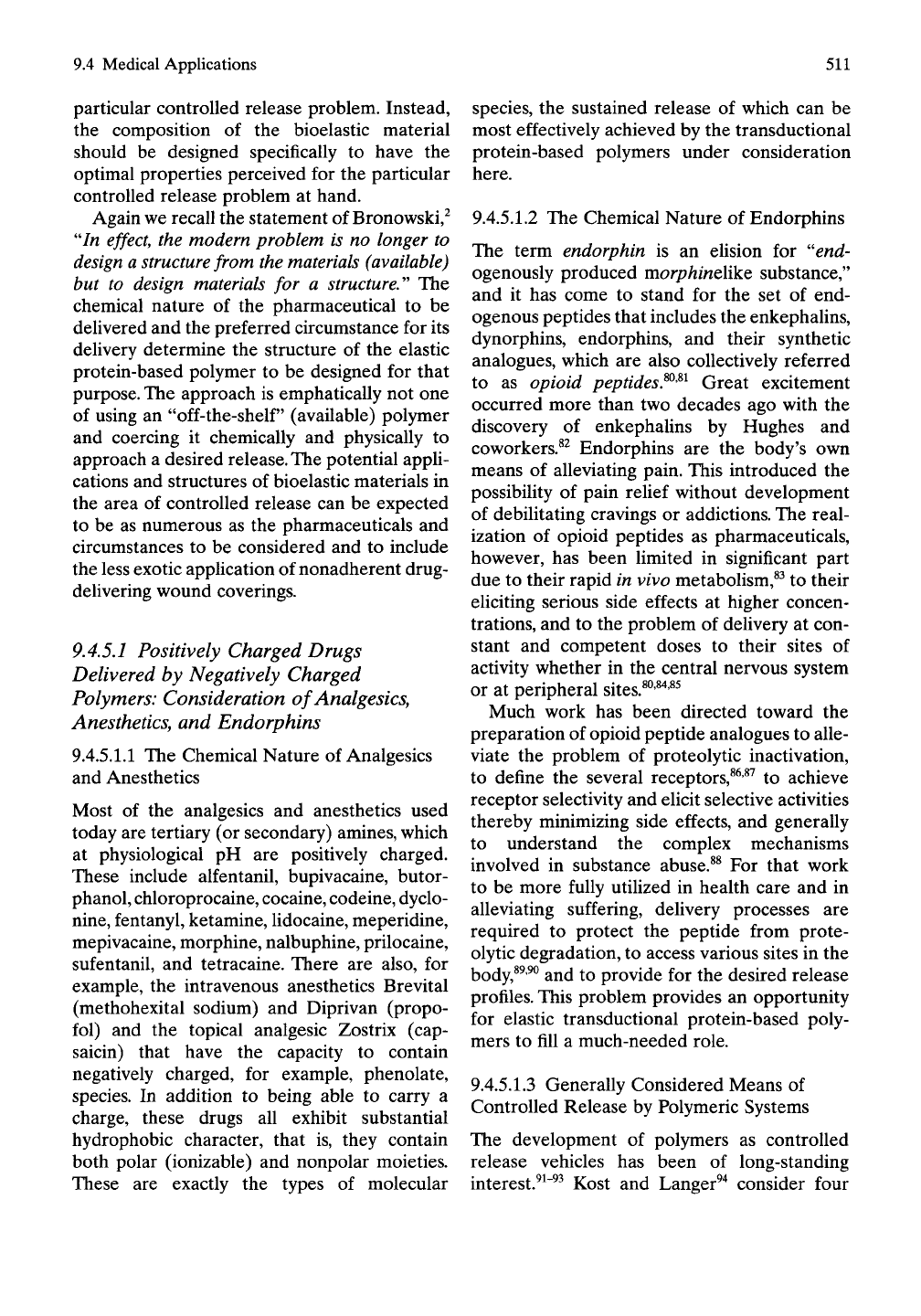
9.4 Medical Applications
511
particular controlled release problem. Instead,
the composition of the bioelastic material
should be designed specifically to have the
optimal properties perceived for the particular
controlled release problem at hand.
Again we recall the statement of Bronowski,^
"/n ejfect, the modern problem is no longer to
design a structure from the materials (available)
but to design materials for a structure.'' The
chemical nature of the pharmaceutical to be
delivered and the preferred circumstance for its
delivery determine the structure of the elastic
protein-based polymer to be designed for that
purpose. The approach is emphatically not one
of using an "off-the-shelf" (available) polymer
and coercing it chemically and physically to
approach a desired release. The potential appU-
cations and structures of bioelastic materials in
the area of controlled release can be expected
to be as numerous as the pharmaceuticals and
circumstances to be considered and to include
the less exotic application of nonadherent drug-
delivering wound coverings.
9.4,5.1 Positively Charged Drugs
Delivered by Negatively Charged
Polymers: Consideration of Analgesics,
Anesthetics, and Endorphins
9.4.5.1.1 The Chemical Nature of Analgesics
and Anesthetics
Most of the analgesics and anesthetics used
today are tertiary (or secondary) amines, which
at physiological pH are positively charged.
These include alfentanil, bupivacaine, butor-
phanol, chloroprocaine, cocaine, codeine, dyclo-
nine,
fentanyl, ketamine, lidocaine, meperidine,
mepivacaine, morphine, nalbuphine, prilocaine,
sufentanil, and tetracaine. There are also, for
example, the intravenous anesthetics Brevital
(methohexital sodium) and Diprivan (propo-
fol) and the topical analgesic Zostrix (cap-
saicin) that have the capacity to contain
negatively charged, for example, phenolate,
species. In addition to being able to carry a
charge, these drugs all exhibit substantial
hydrophobic character, that is, they contain
both polar (ionizable) and nonpolar moieties.
These are exactly the types of molecular
species, the sustained release of which can be
most effectively achieved by the transductional
protein-based polymers under consideration
here.
9.4.5.1.2 The Chemical Nature of Endorphins
The term endorphin is an ehsion for "end-
ogenously produced morp/zmelike substance,"
and it has come to stand for the set of end-
ogenous peptides that includes the enkephahns,
dynorphins, endorphins, and their synthetic
analogues, which are also collectively referred
to as opioid peptides.^^'^^ Great excitement
occurred more than two decades ago with the
discovery of enkephalins by Hughes and
coworkers.^^ Endorphins are the body's own
means of alleviating pain. This introduced the
possibility of pain relief without development
of debihtating cravings or addictions. The real-
ization of opioid peptides as pharmaceuticals,
however, has been limited in significant part
due to their rapid in vivo metabolism,^^ to their
ehciting serious side effects at higher concen-
trations, and to the problem of delivery at con-
stant and competent doses to their sites of
activity whether in the central nervous system
or at peripheral sites.^^'^'^'^^
Much work has been directed toward the
preparation of opioid peptide analogues to alle-
viate the problem of proteolytic inactivation,
to define the several receptors,^^'^^ to achieve
receptor selectivity and elicit selective activities
thereby minimizing side effects, and generally
to understand the complex mechanisms
involved in substance abuse.^^ For that work
to be more fully utilized in health care and in
alleviating suffering, delivery processes are
required to protect the peptide from prote-
olytic degradation, to access various sites in the
body,^^'^ and to provide for the desired release
profiles. This problem provides an opportunity
for elastic transductional protein-based poly-
mers to fill a much-needed role.
9.4.5.1.3 Generally Considered Means of
Controlled Release by Polymeric Systems
The development of polymers as controlled
release vehicles has been of long-standing
interest.^^"^^ Kost and Langer^"^ consider four

512 9. Advanced Materials for the Future
different controlled release systems for poly-
meric hydrogels: (1) diffusion controlled, (2)
chemically controlled, (3) solvent controlled,
and (4) release induced by external factors. Pitt
et al.^^ and Peppas and Korsmeyer^^ list similar
mechanisms. TTiere is another category of
mechanism that stands in its own right and
that encompasses all of the above. It utilizes
the inverse temperature transition and may be
called the Trtype
transductional
mechanism of
general development in this volume.
9.4.5.1.4 The Opportunity for Elastic
Transductional Protein-based Polymers
as Controlled Release Vehicles
Biocompatible and biodegradable polymers
provide the potential for the delivery of
analgesics and anesthetics in an anatomically
localized manner and at sustained optimal dose
levels for alleviating pain. These controlled
release vehicles would eliminate the occurrence
of peak concentrations during which times toxic
reactions are more likely to occur. Transduc-
tional elastic protein-based polymers hold
promise for sustained and even constant (zero
order) release levels of analgesics and anesthet-
ics that would help to alleviate untoward clini-
cal responses. In fact, as discussed below,
transductional protein-based polymers have the
demonstrated capacity to release a cationic
morphine analogue and a cationic opioid
peptide at a constant level for a given surface
area and for periods up to many months. Fur-
thermore, they can be designed to release at pre-
ferred levels and time periods and to be formed
into useful drug delivery
vehicles:
injectable vis-
coelastic implants, injectable nanoparticles and
microspheres, trocar implanted elastic rods,
laparoscope implanted sheets, and patches for
transdermal delivery.
9.4.5.1.5 Zero Order Release of Positively
Charged Leu-enkephalin Amide from
Negatively Charged Polymers
Leu-enkephalin amide (H^-Tyr-Gly-Gly-
Phe-Leu-NH2, LEA^) is a positively charged
opioid peptide from the endorphins that are so
well known for causing the "runner's high."
When added to a solution containing a rela-
tively hydrophobic carboxylate-containing
elastic protein-based polymer, LEA^ induces
phase separation. The positively charged drug
ion pairs with the elastic protein-based polymer
and lowers Tt, the onset temperature for the
inverse temperature transition. In this manner
the drug provides the chemical energy for its
own packaging into the drug delivery
device.
As
the glutamic acid (Glu, E)-containing polymer
becomes more hydrophobic by replacement
of less hydrophobic valine (Val, V) residues
by more hydrophobic phenylalanine (Phe, F)
residues, there occurs an increase in pKa, and
there results an increase in binding affinity of
drug to polymer in the phase separated state.
In the example to be discussed, loading
occurred with a 50% excess of drug over car-
boxylate ion pairing sites. The Leu-enkephalin
amide release profiles in Figure 9.38 were
obtained using a cylindrical tube with a shallow
conical bottom, as also depicted in Figure
9.38B, and replacing the overlying buffer solu-
tion every 24
hours.
^°
Note that the drug deliv-
ery vehicle disperses as the drug is released,
because, in fact, the drug provides the glue that
holds the drug delivery vehicle together. The
excess drug is released during the first 12 days.
Once this has occurred, there follows a remark-
ably constant release, which continues until the
sample is totally dispersed.
For 250 mg of poly(GVGFP GEGFP
GVGVP), zero order release occurs at the level
of
4.7
|Lim/day
for approximately 1 month, and
the turn off is quite abrupt as the materials
come from the bottom conical part of the tube.
For 250 mg of the more hydrophobic protein-
based polymer poly(GEGVP GVGVP GVGFP
GFGFP GVGVP GVGVP), zero order release
is maintained constant for over 1 month at
about 2.7|im/day and again turns off abruptly.
For 250 mg of the most hydrophobic elastic
protein-based polymer, poly(GFGFP GEGFP
GFGFP), of the series, zero order release
is maintained constant for nearly a period
of 3 months at the level of
1.9|im/day
and
again shuts off abruptly. Of course, the initial
burst can be eliminated by not loading with an
excess of drug, but an initial excess may be
helpful in vivo to more quickly establish a
steady state.

9.4 Medical Applications
513
Release Profiles of Leu-enkephaline amide from
Glu-containing Protein-based Polymers
10.0
7.5
•S
I
5.0
2.5 H
0.0
250 mg polymer
loading
conditions:
pH 6.8
° 1.5 equivalents of drug for each
Glu binding site
polyCGVGFP GEGFP GVGVP)
4.7
mole
10
20
days
30 40
10.0
7.5-^
5.0
2.5
0.0
10.0-
250 mg polymer
loading
conditions:
pH 6.8
1.5 equivalents of
drug
for each
J Glu binding site
1
°
1
°
1 DQoa'-'Qoaaaaoaaa
I.I.I.
poly(GEGVP GVGVP GVGFP
GFGFP GVGVP GVGVP)
u
u J
'°°°°°°°°°°°oaaa --- mole
°°a
a
a
1 . 1 . 1
10
20 30
days
40
50
7.5'
5.0
2.5
0.0
250 mg polymer
loading
conditions:
pH 6.8
1.5 equivalents of drug for each
Glu binding site
poly(GFGFP GEGFP GFGFP)
•••^
•*********»»****^^»»<
1.85
mole
/
20 40 60
100
days
FIGURE
9.38. Release of positively charged Leu- release levels are maintained constant out to 3
enkephalin amide from designed, negatively charged months. Initial burst release due to 50% excess drug
polymers with systematically increased hydropho- over polymer sites. (Reproduced with permission
bicity and pKa shifts. For constant surface areas, from Urry et al.^°)

514
9. Advanced Materials for the Future
It is quite clear that the ion-pairing approach
using hydrophobic-induced, pKa-shifted,
anionic sites within polymers capable of inverse
temperature transitions provides a means of
achieving constant release of positively charged
drugs over substantial periods of time. As
discussed below, similar results have been
obtained for the narcotic antagonist naltrexone.
9.4.5.1.6 Drug Addiction Intervention:
Zero Order Release of Positively Charged
Naltrexone from Negatively
Charged Polymers
The approach considered for drug addiction
intervention is to treat the addict, after
withdrawal, to prevent recurrence of active
dependency. An effective drug is the narcotic
antagonist naltrexone. Two nanograms per mil-
Uliter of this drug in the blood plasma can block
the action of a
25
mg dose of heroin and deter
recurrence of active dependency.
The limitation with the use of this drug arises
from the problem of patient compUance. If for
whatever reason the patient feels compelled
again to have the high, the medication is dis-
continued and the addict again becomes
actively dependent. One way to overcome this
problem is a subcutaneous implant of a con-
trolled release device that would maintain an
effective range of drug release for sufficient
periods to get the addict beyond the return to
active dependency. This could be a device that
releases competent doses for 1 month or more.
Naltrexone is a positively charged drug.
Therefore, as for the opioid peptide Leu-
enkephalin amide discussed above, the design of
the bioelastic drug delivery device is one of neg-
atively charged polymers; the two polymers in
Figure 9.38B,C will be discussed for ease of
comparison. The release profiles are contained
in Figure 9.39. For 250 mg of poly(GEGVP
GVGVP GVGFP GFGFP GVGVP GVGVP)
and a 50% excess of naltrexone over the number
of carboxylates, zero order release is maintained
constant for over 1 month at 2.7 |Lim/day (the
same as for Leu-enkephalin amide) and, of
course, turns off abruptly, just as occurred with
Leu-enkephalin amide. For
250
mg of the more
hydrophobic elastic protein-based polymer
poly(GFGFP GEGFP GFGFP), zero order
release of naltrexone continues constant for
Naltrexone Release Profile from Glu-containing Protein-based Polymers
8.0
6.0-
4.0 H
250 mg polymer
loading conditions: pH 7.4
1.5 equivalents of
drug
for each
Glu binding site
poly(GEGVP
GVGVP GVGFP
GFGFP GVGVP
GVGVP)
poly(GFGFP
GEGFP GFGFP
>.e
2.2 mole
2.7 mole
100
FIGURE 9.39. Release of the positively charged nar- levels are maintained constant out to 3 months.
CO tic antagonist naltrexone from negatively charged Initial burst release due to 50% excess drug over
polymers with systematic increases in hydrophobic- polymer sites. (Courtesy Bioelastics Research, Ltd.)
ity and pKa shifts. For constant surface areas, release
